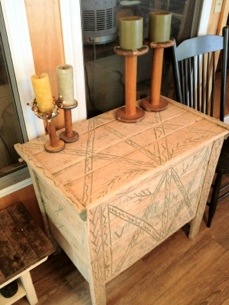— Musings —08.12.2012 02:30 PM
Mystery furniture
This is a picture of The Mystery Furniture, received from Lala to mark the weeks-long Festival of Joy.
It’s up at the cabin, now, and she bought it in Brighton. It is a mystery.
Apparently it comes from Romania, and was handmade by the Roma (don’t tell Col. Kenney). It has wooden hinges and overlapping planks, as if to make it airtight. No nails at all. It apparently was made as a wedding gift in or around 1850.
The markings on the front – V, I, M plus the weird geometrical stuff – are utterly obscure. Latin? Numeric? Some ancient language? Who knows.
Anyone got any theories on this? It’s The Mystery Furniture, and stubbornly so.


Is it a Hope Chest ? They were usually made reasonably air tight.
virtus in media — power in the middle ?
Without more pictures of construction or wood details, hard to tell much. But I find the 1850 date implausible. Wood that has been exposed to the air, even without any UV, changes colour. That wood looks much newer than that, unless it is from something that would not commonly be used for case work – or had a really weird story around where it has been kept.
The lack of nails is not a big surprise, European crafting traditions were highly separated along guild lines. Nails were used by those outside the traditions that would use joinery like a mortise-tenon or dovetail. For a trained joiner, the idea that there might be nails would be insulting. That actually probably also explains the X patterns (is that carved in with a small number of chip-shapes). It doesn’t look that different from very early Massachussetts case/boxes, nor the 16C European patterns they derive from, though much cruder in execution of ornamentation.
How do the planks overlap? Ship-lap, cove & bead, corresponding flat bevels?
First step, figure out what the wood is. Second, figure out how it was turned into the working lumber – hewn when the log was green with froes, or cut with saws and dried in the manner we are more familiar with. That will start to narrow down how it was constructed, and provide some insight as to when.
This piece was found in a barn somewhere in the neck of the world Warren details above. The owner of the store we found it in stripped it down to expose the original wood as it had many coats of paint on it.
I think it’s pine. Pretty light to carry. And the overlaps are just that – like shingles on the side of a house. Never seen anything like that before.
That makes a lot more sense, Roma furniture is basically either willow or painted – the paint would have prevented the expected oxidation, and was done fairly recently. A bit of a shame, the piece was never intended not to be painted.
I would guess it is spruce, not much sign of yellowing, and it is a lot more common in Romania. The Roma in particular have been riving green spruce to make guitars as well as casework for centuries. I am guessing that the grain on the panels is very straight, because they have been riven, split along the radius of the growth circles. That also produces a smooth surface, thought not as smooth as one that had been planed. If you have that grain pattern plus an imperfectly flat surface that does not appear to have been planed, that makes very likely to have been Roma-crafted. Others used those techniques, but they started to disappear in the 1700’s.
How are the panels set into the legs? My guess is that the planks are simply floating in a groove in the legs, put in place green and allowed to dry tight over the years.
I have sent a note to a source who knows infinitely more about these forms, I’ll let you know if he has any insight into the ornamentation or construction.
Whatever it is, it’s beautiful.
VIM maybe the initials of the person who made it.
The geometrics look a little like the Masonic compass and square
That’s what I thought, too. Weirdness.
If the initials are VWM – it could be Very Worshipful Master – a rank in Masonry.
It is beautiful.
Is it the Ark of the Covenant? Be careful opening it.
Next time, consider Ontario-made furniture like this: http://www.mennonitefurniture.com/products.aspx?productid=434 or this: http://www.mennonitefurniture.com/products.aspx?productid=1005
How about the fact that it was purchased by a Mennonite in Ontario? Is that sufficient?
GO Leafs GO! There’s always a good excuse to ignore our own workforce. Showcase a Canadian product.
Works for me.
Check this out. http://www.bbpineantiques.com/romanian-box-beechwood.html
Similar, only beechwood. Same kind of construction and art work.
Too bad your piece was stripped of the paint.
Give them a call, they may have more info.
I like this but ,Furniture In Fashion has gained much popularity due to its affordable prices despite the rising inflation and struggling purchasing power.
I like this but Furniture In Fashion has gained much popularity due to its affordable prices despite the rising inflation and struggling purchasing power.